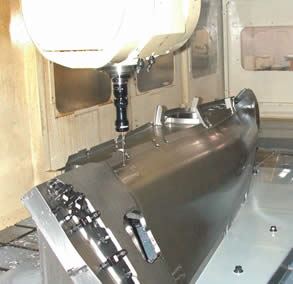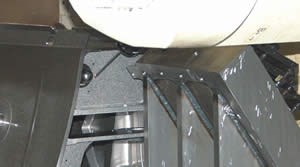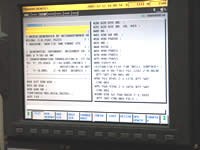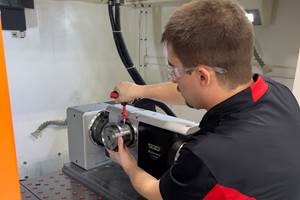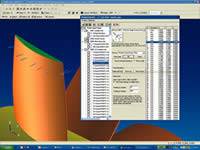Move The Program Instead Of The Part
A complex five-axis part with hard-to-reach datums is machined in two setups instead of eight, thanks to a process that rewrites the tool paths to match the part's position.
The aft boom weldment on a Boeing F/A-22 Raptor fighter aircraft is the sort of part that puts the “hard” in hard tooling.
Various machined features on this 8-foot-long titanium part have to locate with respect to holes and/or complex surfaces in opposing faces of the part. With reference features located on the undersides and beneath the projecting features, certain datums are not accessible to the spindle in the same setup in which the features are machined.
Historically, machining this part has taken eight setups. All eight were risky, because the value of the part falls within the hundreds of thousands of dollars. The steps for machining the part included various inspections of the partially machined work on a CMM to locate datums. Various refixturings on customized hard tooling then let the part locate accurately with respect to different datums for different operations.
The customer for this machining was the GKN Aerospace Chem-tronics Thermal Joining Center in Kent, Washington—the facility where the weldment is welded. This facility not only houses an electron beam welder large enough to accommodate some of the biggest military aircraft parts, but now it also hosts a complementary piece of equipment—a five-axis bridge-type CNC machining center from SNK (Elk Grove Village, Illinois) that allows the facility to perform the previously outsourced machining. Joining this machine is five-axis machining software that lets the bridge mill machine the complex part in just two setups.
Steering The Program
As its name implies, the aft boom weldment locates at the tail of the plane. A bore through the part supports the horizontal stabilizer—the small pair of wings at the tail. The movement of hinged panels on the horizontal stabilizer (the elevators) creates a seemingly small change in the shape of the aircraft that exerts control over the ascent or descent of the plane. This effect provides a serviceable metaphor for the five-axis software, which compensates for position uncertainty to “steer” the NC program in the direction of the part.
Close The software, “NC Transformer Plus” from Numerical Control Software Solutions (Redding, California), could be thought of as a custom fixture for the program instead of the part. It uses data from the machine tool probe to compare the actual positions of reference features of the part to their expected positions. The software then compensates not only for X-Y-Z variations in the location of the part, but also for angular variations. It does this by quickly and thoroughly rewriting the posted NC file so that the program’s tool paths are matched to where the part happens to sit. The coordinate system doesn’t change. Instead, thanks to the software, the program shifts within this fixed coordinate system, with the software changing the axes and coordinates of every interpolated tool path accordingly. The software can even perform this function multiple times in the same setup, with one NC file producing a feature that is inspected and used as a datum for a subsequent NC file.
As a result of the use of this software, there is no need for custom fixturing to hold the part in a precise location and orientation. The machine uses its probe to find where the part sits, and the software ensures that even a complex program with contoured five-axis moves will match the part’s position.
How well the software does its transformations is directly determined by the accuracy of the probe measurements. The GKN facility uses the MP700E probe from Renishaw (Hoffman Estates, Illinois), a probe that improves accuracy by employing strain gage technology to detect triggers instead of using moving parts. The accuracy of probing measurements is particularly important in this application, because some probed features already have a layer of uncertainty. Part of the ingenuity of the process, and part of what allows the weldment to be machined in two setups, is that unreachable datums of the part are referenced to datum spheres that are added in accessible places. Both features are measured on a CMM before machining. The probe therefore does not measure the critical features themselves, but instead measures the spheres that refer to them.
Speed And Quality
The NC Transformer software was developed and proven in the course of developing the aft boom weldment machining process. Initially, watching the software begin to work in this application was scary to those involved. Although custom fixturing may be cumbersome and demanding, a process that involves setting up the part more casually, along with rewriting posted lines of code, can seem as though it doesn’t have enough reassuring “hardness” in it.
However, the process works. It delivers the aft boom part faster and more reliably than the previous process could. And because the process does not rely on any hard tooling, it can be applied to other large and complex five-axis parts in the shop. In fact, now that the facility can perform five-axis machining to a level of effectiveness and quality that rivals that of many machining houses, the Thermal Joining Center has already applied the process to other machining jobs that it previously would have outsourced.
Related Content
What to Do When Five-Axis Machining Is Off the Table
For Fischer USA, 3+2 machining with a high-precision rotary table adds flexibility without the cost of a full five-axis machine.
Read MoreAdditive/Subtractive Hybrid CNC Machine Tools Continue to Make Gains (Includes Video)
The hybrid machine tool is an idea that continues to advance. Two important developments of recent years expand the possibilities for this platform.
Read MoreThree-Axis Bridge Mill Opens New Doors for Construction OEM
Different industries often require different machining priorities, a truism recently demonstrated by Barbco, an OEM of heavy-duty boring equipment that opened up new design possibilities by pivoting toward rigid, less complex machining centers.
Read MoreLean Approach to Automated Machine Tending Delivers Quicker Paths to Success
Almost any shop can automate at least some of its production, even in low-volume, high-mix applications. The key to getting started is finding the simplest solutions that fit your requirements. It helps to work with an automation partner that understands your needs.
Read MoreRead Next
When Probing Is Pivotal
Software for using the probe at angles expands the productive capabilities of this plant’s five-axis machine.
Read MoreObscure CNC Features That Can Help (or Hurt) You
You cannot begin to take advantage of an available feature if you do not know it exists. Conversely, you will not know how to avoid CNC features that may be detrimental to your process.
Read MoreThe Cut Scene: The Finer Details of Large-Format Machining
Small details and features can have an outsized impact on large parts, such as Barbco’s collapsible utility drill head.
Read More
.jpg;width=70;height=70;mode=crop)



